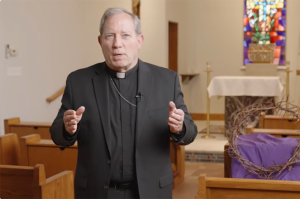Do Books of the Bible Contradict Themselves? Christian Apologist Lee Strobel Answers

Slightly differing accounts of the discovery of Christ's empty tomb in the books of Matthew, Mark and Luke are easy targets for skeptics who are looking to discredit the Bible, but one Christian apologist seeks to clear up those misconceptions.
In his newly revised New York Times best-selling book, The Case for Christ: A Journalist's Personal Investigation of the Evidence for Jesus, Christian apologist Lee Strobel speaks to the skepticism that "seems to penetrate to the heart of the reliability of the empty tomb narratives," he writes in his book.
Strobel mentions one critic in particular, deceased agnostic Charles Templeton, who notes that the Gospels of Matthew, Mark and Luke offer different descriptions of what occurred during the discovery of the empty tomb and each, as Strobel quotes Templeton in the book, "' ... differ so markedly at so many points that with all the good will in the world, they cannot be reconciled.'"
Many of the perceived discrepancies between passages found in Matthew, Mark and Luke are summarized by retired Boston University professor Michael Martin who taught the philosophy of atheism and is cited in Strobel's book, The Case for Christ. Two examples are included below:
Matthew 28:2:
(Layman's terms)
Mary Magdalene and the other Mary arrive at the tomb near dawn and find a rock in front of it. They experience a violent earthquake, and an angel descends and rolls back the stone and sits on it:
(Bible)
"Mary Magdalene and the other Mary went to see the tomb. And suddenly there was a great earthquake; for an angel of the Lord, descending from Heaven, came and rolled back the stone and sat on it." (KJV)
Mark 16:1-5
(Layman's terms)
The Gospel of Mark adds Salome to the mix, a woman not mentioned in Matthew. Here the women arrive at the tomb at sunrise and find the stone already rolled back, unlike in Matthew:
(Bible)
"And when the Sabbath was past, Mary Magdalene, and Mary the mother of James, and Salome, had bought sweet spices, that they might come and anoint him. And very early in the morning the first day of the week, they came unto the sepulchre at the rising of the sun. And they said among themselves, Who shall roll us away the stone from the door of the sepulchre? And when they looked, they saw that the stone was rolled away: for it was very great. And entering into the sepulchre, they saw a young man sitting on the right side, clothed in a long white garment; and they were affrighted." (KJV)
Here, there is no mention of an earthquake or an angel who descends from Heaven and rolls back the stone as in the book of Matthew.
Another point where the details don't necessarily jive is in the Gospels of Luke and Mark.
Luke 24:1-4
(Layman's terms)
Luke coincides with Matthew 28:2 above in that they both agree that an angel sits on the rock outside the tomb. In Mark 16:1-5, however, one "young man" is reported to be inside the tomb, while Luke reports that two men are inside.
(Bible)
"Now upon the first day of the week, very early in the morning, they came unto the sepulchre, bringing the spices which they had prepared, and certain others with them. And they found the stone rolled away from the sepulchre. And they entered in, and found not the body of the Lord Jesus. And it came to pass, as they were much perplexed thereabout, behold, two men stood by them in shining garments." (KJV)
Apologist and Bible expert analysis
In an effort to reconcile these differences, and perhaps calm the chatter among those who question the Bible on this issue, Strobel consults Bible expert William Lane Craig, PhD, asking, "In light of all this, how in the world can you possibly consider the empty tomb story to be credible?"
Craig says that historians examine the overall narrative and say, "I see some inconsistencies, but I notice something about them: they're all in the secondary details."
"The core of the story is the same: Joseph of Arimathea takes the body of Jesus, puts it in a tomb, the tomb is visited by a small group of women followers of Jesus early on the Sunday morning following His crucifixion, and they find that the tomb is empty. They see a vision of angels saying that Jesus is risen."
He continues, "The careful historian, unlike the philosopher, doesn't throw out the baby with the bathwater. He says, 'This suggests that there is a historical core to this story that is reliable and can be depended upon, however conflicting the secondary details might be.'"
"So we can have great confidence in the core that's common to the narratives and that would be agreed upon by the majority of New Testament scholars today, even if there are some differences concerning the names of the women, the exact time of the morning, the number of the angels, and so forth. Those kinds of secondary discrepancies wouldn't bother a historian."
The Case for Christ can be found everywhere books are sold. For more information about Lee Strobel, click here.




























